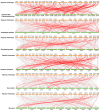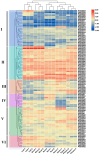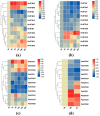Genome-Wide Characterization of the BTB Gene Family in Poplar and Expression Analysis in Response to Hormones and Biotic/Abiotic Stresses
- PMID: 39201733
- PMCID: PMC11354360
- DOI: 10.3390/ijms25169048
Genome-Wide Characterization of the BTB Gene Family in Poplar and Expression Analysis in Response to Hormones and Biotic/Abiotic Stresses
Abstract
The BTB (Broad-complex, tramtrack, and bric-a-brac) gene family, characterized by a highly conserved BTB domain, is implicated in a spectrum of biological processes, encompassing growth and development, as well as stress responses. Characterization and functional studies of BTB genes in poplar are still limited, especially regarding their response to hormones and biotic/abiotic stresses. In this study, we conducted an HMMER search in conjunction with BLASTp and identified 95 BTB gene models in Populus trichocarpa. Through domain motif and phylogenetic relationship analyses, these proteins were classified into eight families, NPH3, TAZ, Ankyrin, only BTB, BACK, Armadillo, TPR, and MATH. Collinearity analysis of poplar BTB genes with homologs in six other species elucidated evolutionary relationships and functional conservations. RNA-seq analysis of five tissues of poplar identified BTB genes as playing a pivotal role during developmental processes. Comprehensive RT-qPCR analysis of 11 BTB genes across leaves, roots, and xylem tissues revealed their responsive expression patterns under diverse hormonal and biotic/abiotic stress conditions, with varying degrees of regulation observed in the results. This study marks the first in-depth exploration of the BTB gene family in poplar, providing insights into the potential roles of BTB genes in hormonal regulation and response to stress.
Keywords: BTB gene family; Populus trichocarpa; biotic/abiotic stresses; expression patterns; hormones treatment.
Conflict of interest statement
The authors declare no conflicts of interest.
Figures









Similar articles
-
Genome-Wide Analysis of Aquaporins Gene Family in Populus euphratica and Its Expression Patterns in Response to Drought, Salt Stress, and Phytohormones.Int J Mol Sci. 2024 Sep 23;25(18):10185. doi: 10.3390/ijms251810185. Int J Mol Sci. 2024. PMID: 39337672 Free PMC article.
-
Genome-wide identification and characterization of the Populus WRKY transcription factor family and analysis of their expression in response to biotic and abiotic stresses.J Exp Bot. 2014 Dec;65(22):6629-44. doi: 10.1093/jxb/eru381. Epub 2014 Sep 23. J Exp Bot. 2014. PMID: 25249073 Free PMC article.
-
Genome-wide search and structural and functional analyses for late embryogenesis-abundant (LEA) gene family in poplar.BMC Plant Biol. 2021 Feb 24;21(1):110. doi: 10.1186/s12870-021-02872-3. BMC Plant Biol. 2021. PMID: 33627082 Free PMC article.
-
Genome-Wide Analysis of Strictosidine Synthase-like Gene Family Revealed Their Response to Biotic/Abiotic Stress in Poplar.Int J Mol Sci. 2023 Jun 14;24(12):10117. doi: 10.3390/ijms241210117. Int J Mol Sci. 2023. PMID: 37373265 Free PMC article.
-
Genome-wide identification and expression analysis of the Dof gene family reveals their involvement in hormone response and abiotic stresses in sunflower (Helianthus annuus L.).Gene. 2024 Jun 5;910:148336. doi: 10.1016/j.gene.2024.148336. Epub 2024 Mar 4. Gene. 2024. PMID: 38447680 Review.
Cited by
-
Genome-Wide Identification of the BTB Domain-Containing Protein Gene Family in Pepper (Capsicum annuum L.).Int J Mol Sci. 2025 Apr 6;26(7):3429. doi: 10.3390/ijms26073429. Int J Mol Sci. 2025. PMID: 40244299 Free PMC article.
-
Omics-Based Characterization of BTB Gene Family in T. aestivum, Reveals the Potential of TaBTB11/56/57/58 in Combined Heat and Drought Stress Regulation.Rice (N Y). 2025 Jul 11;18(1):64. doi: 10.1186/s12284-025-00808-1. Rice (N Y). 2025. PMID: 40643720 Free PMC article.
-
Genome-Wide Identification, Characterization, and Expression Analysis of the BTB domain-Containing Protein Gene Family in Poplar.Biochem Genet. 2025 Mar 20. doi: 10.1007/s10528-025-11083-6. Online ahead of print. Biochem Genet. 2025. PMID: 40111703
References
MeSH terms
Substances
LinkOut - more resources
Full Text Sources

